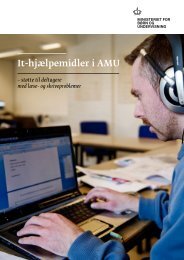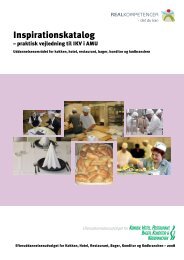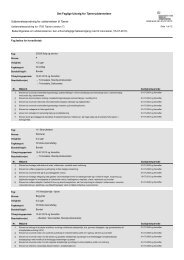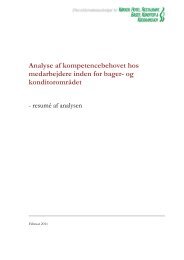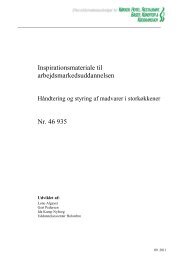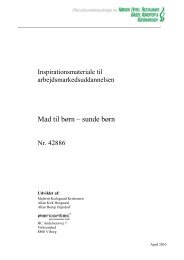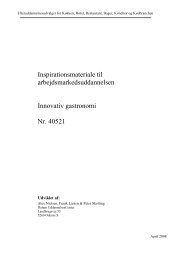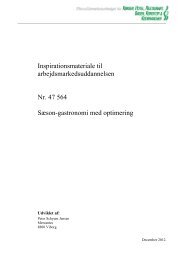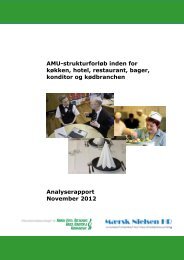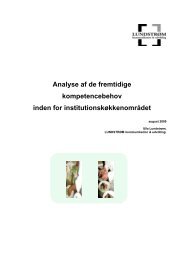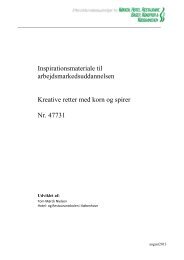General food hygiene - the certificate training
General food hygiene - the certificate training
General food hygiene - the certificate training
Create successful ePaper yourself
Turn your PDF publications into a flip-book with our unique Google optimized e-Paper software.
Contamination of <strong>food</strong>stuff<br />
Contamination from physical things<br />
Pebbles in rye bread, insects in muesli, eggshells in pastry, splinters of wood from utensils, hair,<br />
kitchen cloths, cigarette buds and paper clips. A lot of people have experienced <strong>the</strong>se kinds of<br />
unpleasant surprises in <strong>the</strong> <strong>food</strong>. Everybody must be aware of traces of pests (mice and rats), for<br />
example faeces on shelves and bite marks in <strong>food</strong>stuff and packaging.<br />
*3 Contamination from chemical substances<br />
Most <strong>food</strong>stuffs are being processed or prepared before it is eaten. We have been cooking, frying,<br />
smoke curing and backing our <strong>food</strong>stuff for millenniums, but new kinds of methods to process or<br />
prepare <strong>food</strong>, as microwaving, radiation and high pressure treatment are also being developed.<br />
Substances that can form during processing and preparation of <strong>food</strong>stuff are frying mutagens and<br />
acryl amide.<br />
Unwanted substances can get into <strong>food</strong>stuff from packaging and kitchen utensils, pesticides and<br />
heavy metals. A chemical contamination can also arise when cleaning. It can arise from cleaning<br />
and disinfection agents, which are not washed properly away from a table.<br />
Natural toxic substances are usually found in sufficiently small amounts not to pose a health risk for<br />
humans. But poisonous lectins are found in dry uncooked beans; however <strong>the</strong>se are destroyed by<br />
heat. Also solanine found in potatoes and histamine found in fish, are chemical poisons. Pregnant<br />
women should restrain <strong>the</strong>mselves from caffeine from coffee or coke and persons with high blood<br />
pressure should not eat too much liquorice.<br />
Contamination from microorganisms<br />
Microorganisms are found everywhere. You can not avoid that some end up in <strong>the</strong> <strong>food</strong>, that <strong>the</strong><br />
<strong>food</strong> becomes microbiologically contaminated. Some of <strong>the</strong> bacteria are destroying and will make<br />
to <strong>food</strong> go rotten and still o<strong>the</strong>rs are useful, but <strong>the</strong> pathogenic bacteria can make humans ill. This<br />
can happen if <strong>the</strong> microorganisms are present at a sufficient level in <strong>the</strong> <strong>food</strong> or if toxins have been<br />
produced. The <strong>food</strong> does not go rotten by pathogenic bacteria. Thus often you will not be able to<br />
see, smell or taste if pathogenic bacteria are present in <strong>the</strong> <strong>food</strong>.<br />
***2 fotos<br />
Tekst 1:<br />
You must take as many precautions as you can to secure that <strong>the</strong>se kinds of small things does not<br />
end up in <strong>the</strong> <strong>food</strong>. Think about <strong>the</strong> contents of your pockets and keep an eye on <strong>the</strong> <strong>food</strong><br />
throughout <strong>the</strong> whole production.<br />
Text 2:<br />
Chemical contamination is not visible.<br />
12



